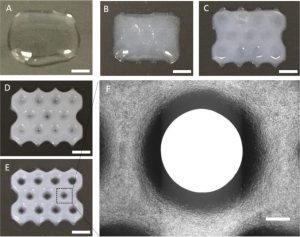3D bioprinting is an exciting subject – and a highly complex one. Organs don’t just materialize out of a 3D printer; there’s a long process that must be undertaken. In order to 3D print biological tissue, the correct kinds of ink must be used. These inks must be of a viscosity that can be extruded yet hold their shape after extrusion, and they must be able to support live cells. Numerous researchers have tried multiple formulations, with varying success rates, and recently a group of scientists came up with a promising new bioink made from alginate and cellulose nanocrystals (CNCs). You can read about their research here in a paper entitled “3D bioprinting of liver-mimetic construct with alginate/cellulose nanocrystal hybrid bioink.”
“This bioink possesses excellent shear-thinning property, can be easily extruded through the nozzle, and provides good initial shape fidelity,” the researchers state. “It has been demonstrated that the viscosities during extrusion were at least two orders of magnitude lower than those at small shear rates, enabling the bioinks to be extruded through the nozzle (100 µm inner diameter) readily without clogging.”
They used the bioink to 3D print a honeycomb structure that contains fibroblast and hepatoma cells and mimics a human liver. The 3D printed structures were crosslinked with CaCl2 and incubated and cultured for three days. They discovered that the 3D bioprinting process resulted in minimal cell damage.
Alginate is a natural polymer that has been used for numerous bioink formulations. It is biocompatible and easily processable, yet its rheological properties result in poor printability and pattern fidelity, which means that it must be combined with something else – in this case, CNCs, which are rod-like or whisker-shaped nanoparticles extracted from the crystalline regions of cellulose fibers. Cellulose is a natural material that serves as the main component of plant cell walls and has shown a lot of promise as a 3D printing material. It has been widely studied for tissue engineering applications as well, thanks to its renewability, low density, high mechanical strength, large and highly reactive surfaces, and low cytotoxicity.
 The alginate and CNC bioink performed extremely well. It demonstrated excellent shear-thinning properties, meaning that its viscosity decreases under the pressure of an extruder nozzle, enabling it to be printed easily. It held its shape well after printing, and induced minimal cell death among the liver cells it was seeded with. The researchers conclude that the bioink has good potential for 3D bioprinting.
The alginate and CNC bioink performed extremely well. It demonstrated excellent shear-thinning properties, meaning that its viscosity decreases under the pressure of an extruder nozzle, enabling it to be printed easily. It held its shape well after printing, and induced minimal cell death among the liver cells it was seeded with. The researchers conclude that the bioink has good potential for 3D bioprinting.
This may not seem like a massive development compared to, say, the 3D printing of a thyroid, but in the big picture, it’s exciting news. The development of a new, promising bioink means that scientists have more to work with in the pursuit of 3D printing better tissues for research purposes and, ultimately, 3D printing organs. Before we can see more major advancements in 3D bioprinting, the building blocks need to be there, and this particular study has resulted in some strong building blocks.
Authors of the paper include Yun Wu, Zhi Yuan (William) Lin, Andrew C. Wenger, Kam C. Tam, and Xiaowu (Shirley) Tang.
Discuss this and other 3D printing topics at 3DPrintBoard.com or share your thoughts below.
Subscribe to Our Email Newsletter
Stay up-to-date on all the latest news from the 3D printing industry and receive information and offers from third party vendors.
Print Services
Upload your 3D Models and get them printed quickly and efficiently.
You May Also Like
Johns Hopkins University Researchers Develop HyFAM Technology
Two scientists from Johns Hopkins University, Nathan C. Brown and Jochen Mueller, have developed a hybrid manufacturing technology they call HyFam, or Hybrid Formative Additive Manufacturing. Their work on this technology...
3D Printing G-Code Gets an Upgrade: T-Code
Good old G-Code still manages many 3D printers, great and small. Just like the STL, it’s a standard that enables collaboration while also holding the additive manufacturing (AM) industry back....
AM Rewind: The Biggest News and Trends of 2024
After a sluggish 2023, driven by persistent inflation and geopolitical tensions, 2024 has seen some recovery. Economic growth climbed from about 2.8 percent in 2023 to a modest 3.2 percent...
Metal Wire 3D Printer OEM ValCUN Announces Plans for 2025 Expansion
ValCUN, a Belgian original equipment manufacturer (OEM) of wire-based metal additive manufacturing (AM) hardware, has announced that the company has entered the next phase of its growth trajectory, making key...



































